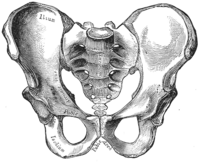
Photo from wikipedia
BACKGROUND Pelvic floor muscles (PFM) are important for lumbar stability. However, the relationship between lumbar and hip motion angle changes (MAC) caused by PFM contraction and each PFM's function remains… Click to show full abstract
BACKGROUND Pelvic floor muscles (PFM) are important for lumbar stability. However, the relationship between lumbar and hip motion angle changes (MAC) caused by PFM contraction and each PFM's function remains unclear. OBJECTIVE To clarify the lumbar spine and hip motion changes produced by PFM contraction and the relationship between MAC and PFM function. METHODS In 21 healthy females, motion angle was measured for prone hip extension movement using natural movement (NM), PFM contracting movement (PM), and reducing lumbar movement (RM) methods. The PFM functional indices were bladder base elevation distance, continuous bladder base elevation time, and pelvic floor location. RESULTS The PM showed no significant difference in lumbar motion angle but had significantly smaller hip motion than the NM (NM; 26.1 ± 8.3, PM; 29.2 ± 11.0). MAC was significantly greater in RM (lumbar spine; 4.4 ± 3.2, hip; 5.9 ± 8.7) than in PM (lumbar spine; 0.4 ± 4.4, hip; 3.1 ± 5.1) for both the lumbar spine and hip. Lumbar spine and hip MAC of PM was significantly correlated with pelvic floor location (lumbar spine; r=-0.44, hip; r= 0.54). CONCLUSION PFM contraction does not attenuate lumbar spine motion but reduces hip motion. MAC due to PFM contraction during lumbar movement tasks is related to the PFM functional index.
Journal Title: Journal of back and musculoskeletal rehabilitation
Year Published: 2022
Link to full text (if available)
Share on Social Media: Sign Up to like & get
recommendations!